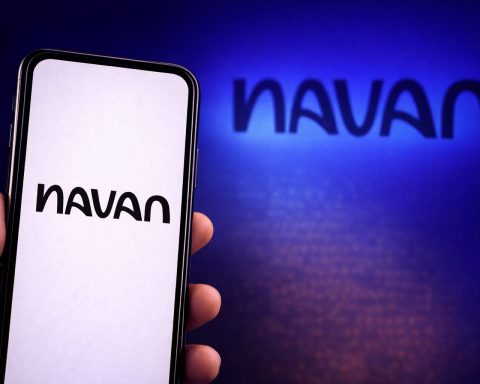Snap Inc. (NYSE: SNAP), the parent company of Snapchat, finished Tuesday’s session modestly lower, giving back a sliver of its early‑November AI-fueled rally as investors digested strong third‑quarter results, a $400 million artificial intelligence partnership, and fresh regulatory headwinds in Australia. [1]
As of the close on November 25, 2025, SNAP stock ended at $7.64, down about 0.5% on the day. The shares traded between $7.59 and $7.76 on volume just over 30.9 million, leaving the company with a market capitalization around $13.1 billion. That puts Snap roughly 11% above its 52‑week low of $6.90 but still about 40% below its 52‑week high of $13.28, a reminder of how volatile the name has been in 2025. [2]
Key takeaways for SNAP stock on November 25, 2025
- Price action: SNAP closed at $7.64, essentially consolidating after this month’s double‑digit pop following Q3 earnings and an AI partnership announcement. [3]
- Fundamentals: Q3 2025 revenue grew 10% year over year to about $1.51 billion, while net losses narrowed and free cash flow turned positive, even though the company remains unprofitable overall. [4]
- AI & growth story: Snap struck a $400 million, one‑year deal with Perplexity AI and authorized up to $500 million in share repurchases, signaling an AI‑driven product roadmap and shareholder‑return ambitions. [5]
- Regulatory risk: A new social media ban for under‑16s in Australia is forcing Snap to roll out bank‑linked age verification, potentially pressuring engagement metrics in that market. [6]
- Street view: Analysts overall rate SNAP a “Hold”, with an average 12‑month target price around $10.40, implying roughly 36% upside from today’s close — but with meaningful execution and regulatory risk attached. [7]
SNAP stock price today: consolidating after the AI spike
Snap shares have cooled off from the explosive move seen earlier this month, when the stock jumped double digits after the company reported better‑than‑expected Q3 revenue and unveiled its Perplexity AI partnership and buyback plan. [8]
At $7.64, SNAP trades at roughly 2.3 times trailing 12‑month revenue, based on about $5.77 billion in sales over the last year and a market value near $13.1 billion. The company still posts a net loss (about $497 million over the trailing 12 months), implying a negative net margin of roughly 9%, but its improving cash‑flow profile suggests the business is slowly moving in the right direction. [9]
For short‑term traders, today’s muted slip looks more like digestion than a new trend: the stock is sitting near the middle of its recent post‑earnings range, with no fresh company‑specific headline dramatically shifting the narrative during Tuesday’s session.
Q3 2025 earnings: revenue growth and losses narrowing
Snap’s third‑quarter 2025 results, released on November 5, form the backbone of the current SNAP stock story.
- Revenue: Q3 revenue rose 10% year over year to $1.507 billion, beating consensus estimates of roughly $1.49 billion. [10]
- Users:
- Daily Active Users (DAUs) climbed 8% YoY to 477 million.
- Monthly Active Users (MAUs) increased 7% YoY to 943 million. [11]
- Profitability trends:
- Net loss improved to roughly $104 million, down more than 30% from a year earlier.
- Adjusted EBITDA reached $182 million, up $50 million year over year, for an adjusted EBITDA margin of about 12%.
- Free cash flow hit $93 million, and operating cash flow was $146 million. [12]
- Monetization:
- Global ARPU (average revenue per user) ticked up about 2% YoY to $3.16.
- Advertising revenue grew roughly 5% YoY to about $1.32 billion, driven by improvements in direct‑response advertising tools and better ad‑targeting models. [13]
Beyond ad sales, Snap’s diversification efforts are starting to show up in the numbers. “Other revenue,” which is mostly Snapchat+ subscriptions and other paid products, surged 54% year over year to $190 million in Q3, giving Snap an annualized subscription run rate north of $750 million. Management said Snapchat+ subscribers are now approaching 17 million, underscoring growing traction for its premium offerings. [14]
Together, these figures paint a picture of a business that’s growing at a high single‑ to low double‑digit clip, narrowing losses, and gradually strengthening its balance between advertising and direct revenue — but not yet out of the woods from a profitability standpoint.
AI push: Perplexity deal, AR leadership and Snap’s platform ambitions
A big reason SNAP stock ripped higher after earnings was the company’s high‑profile AI partnership with Perplexity, which markets an AI‑powered answer engine.
According to Snap and Investopedia’s summary of the deal, Perplexity will pay Snap $400 million over one year, using a mix of cash and equity, to integrate its conversational search technology directly into Snapchat. The integration is scheduled to roll out early next year. [15]
Snap frames this as the first step in turning Snapchat into a platform where leading AI companies can plug into its global community rather than just a standalone app. For investors, that means:
- A new, high‑margin revenue stream from the Perplexity payments.
- Potentially higher engagement, if conversational search becomes a sticky feature inside Snapchat.
- Greater strategic relevance in the AI ecosystem, which could support future partnerships or monetization routes.
This AI push builds on Snap’s long‑standing augmented reality (AR) lead. The company highlights that more than 350 million people engage with AR experiences daily, and Snapchatters use AR Lenses more than 8 billion times per day. Over 400,000 creators have built more than 4 million lenses, making Snap one of the most scaled AR platforms globally. [16]
If Snap can combine AR leadership, conversational AI, and its growing subscription base, the company could ultimately push beyond advertising dependence — but execution risk is high, and investors know it.
Product momentum: Topic Chats and new engagement surfaces
On the product side, Snap is also experimenting with new ways to keep users engaged and create more advertising inventory.
Earlier this month, Snapchat rolled out “Topic Chats”, a feature that lets users join public chatrooms around themes like sports, TV shows, or trending events. These Topic Chats appear across the app — in chat shortcuts, search, the Stories page and Spotlight — and can also surface related short‑form Spotlight videos. Snap says it will use large language models and other moderation tools to keep conversations safe and aligned with its Community Guidelines, with messages retained for up to five years. [17]
For SNAP stock, the key question is whether Topic Chats and similar features:
- Boost time spent and content consumption.
- Expand targetable ad inventory, especially in public spaces like Spotlight.
- Help Snap defend its niche against TikTok, Instagram Reels, and YouTube Shorts.
If they succeed, these features could support ARPU growth and reinforce the bullish case that Snap can still innovate its way into durable relevance with younger demographics.
Regulatory headwinds: Australia’s teen social media ban
Not all of the recent headlines have been bullish for Snap.
In Australia, lawmakers are preparing to enforce a world‑first social media ban for children under 16, set to take effect on December 10, 2025. In response, Snap announced it will let Australian users verify their age through ConnectID, a bank‑linked identity tool used by major Australian banks, as well as k‑ID, a third‑party age‑assurance provider that uses selfies or government ID. [18]
Key details from Reuters’ reporting:
- Snap estimates it has about 440,000 Australian users aged 13–15, making it one of the most affected platforms under the new law.
- ConnectID will send Snapchat a simple “yes/no” age signal based on bank account data, without sharing sensitive payment details.
- Platforms that fail to comply face potential fines of up to A$49.5 million (about $32 million). [19]
While Australia is a relatively small slice of Snap’s global user base, the move illustrates the regulatory overhang facing social‑media companies worldwide. Upcoming age‑verification rules in other regions — which Snap itself has flagged as likely — could pressure user growth and engagement, even as they aim to improve child safety. [20]
Street sentiment: “Hold” consensus and 12‑month price targets
Despite the recent AI excitement, Wall Street’s stance on SNAP remains cautious.
Data compiled by StockAnalysis and MarketBeat show that: [21]
- SNAP carries an average analyst rating of “Hold.”
- The consensus 12‑month price target is about $10.40, implying roughly 36% upside from Tuesday’s close.
- A majority of covering analysts are neutral, with a mix of upgraded “neutral/market perform” ratings after Q3 and a smaller number of outright “buy” and “sell” calls.
Fundamentally, Snap’s trailing numbers explain the caution:
- Revenue (TTM): about $5.77 billion.
- Net income (TTM): roughly –$496.6 million, meaning Snap is still loss‑making.
- EPS (TTM): about –$0.29; traditional P/E is not meaningful, though the forward P/E is in the high‑teens based on next year’s expected earnings. [22]
In its guidance, Snap expects Q4 2025 revenue between $1.68 billion and $1.71 billion, implying about 8–10% year‑over‑year growth, and projects adjusted EBITDA of $280–$310 million while keeping a tight rein on operating expenses. [23]
Taken together, analysts see a company with:
- Clear paths to incremental profitability and free‑cash‑flow growth.
- Persistent challenges around competition, regulation, and user engagement trends.
Hence the “show‑me” valuation: not distressed, but not rewarded with a premium growth multiple either.
Institutional buying vs. insider selling
Another piece of today’s narrative comes from ownership trends.
A fresh MarketBeat report notes that Magnetar Financial LLC increased its Snap stake by about 152.8% in Q2, acquiring 60,767 more shares to bring its total to 100,525 shares, valued around $874,000 at the time of filing. Several other large investors, including Vanguard and AQR, have also added to positions, contributing to institutional ownership around 47–48% of the float. [24]
At the same time, insiders have been taking some money off the table:
- Snap’s CTO Robert Murphy sold roughly 1 million shares in recent weeks.
- CFO Derek Andersen and other executives have also reported multiple stock sales, according to recent filings. [25]
Institutional buying combined with insider selling doesn’t automatically cancel out — insiders often sell for diversification or tax reasons, while institutions may be positioning for multi‑year outcomes. But this mixed flow underlines that SNAP is still viewed as a high‑beta, debate‑rich name, not a straightforward secular winner.
Remember April: ad market jitters still linger
Investors also haven’t forgotten how fragile sentiment around Snap can be.
Back on April 30, 2025, Snap’s shares plunged more than 15% in a single session after the company declined to provide a forecast and cautioned about slowing ad spend, especially from Chinese e‑commerce advertisers like Temu and Shein amid U.S. tariff changes. That sell‑off wiped roughly $2 billion off Snap’s market value in a day and sparked a wave of price‑target cuts. [26]
The contrast between that episode and November’s upbeat reaction to Q3 results shows just how much macro conditions and advertiser confidence still drive SNAP stock, even as Snap leans into subscriptions and AI‑powered products.
Key risks and opportunities for SNAP stock from here
Opportunities:
- AI and AR leadership: The Perplexity deal, Snap’s deep AR ecosystem, and ongoing investment in machine learning give it differentiated tech assets that could be monetized more fully over time. [27]
- Subscription growth: Snapchat+ and new storage and premium bundles are scaling quickly and could meaningfully lift margins if adoption continues. [28]
- International and SMB momentum: Faster growth in Europe and the “Rest of World,” along with strong small‑business ad demand, diversify Snap’s revenue base beyond large North American brand advertisers. [29]
Risks:
- Regulation: Age‑verification rules like Australia’s teen social media ban may spread, pressuring reported user metrics and engagement in key markets. [30]
- Competition: TikTok, Instagram Reels, and YouTube Shorts remain intense rivals for young users’ attention and ad dollars.
- Profitability and dilution: Snap is still unprofitable on a GAAP basis, relies heavily on stock‑based compensation, and has authorized another share repurchase program partly to offset dilution. [31]
- Ad‑cycle sensitivity: As April’s sell‑off showed, any renewed slowdown in digital ad spend or guidance misstep could trigger sharp downside moves. [32]
What today’s move could mean for traders and long‑term investors
For short‑term traders, today’s modest dip looks like a typical consolidation day after a big news‑driven rally. SNAP is sitting in the lower‑mid half of its recent range, with obvious catalysts (AI roll‑out, Q4 numbers, regulatory updates) still ahead.
For longer‑term investors, the story remains nuanced:
- Snap is growing revenue at ~10%, improving margins, and generating consistent positive free cash flow on a quarterly basis. [33]
- The company is re‑positioning itself around AI, AR, and subscriptions, which could improve its competitive moat if execution goes to plan.
- But SNAP still carries meaningful risk tied to regulation, competition, user engagement trends, and the inherent volatility of ad‑supported business models.
Whether SNAP fits in a portfolio will depend heavily on each investor’s risk tolerance, time horizon, and view on Snap’s ability to turn product innovation into durable earnings power. Anyone considering the stock should carefully review the company’s latest filings, earnings call transcripts, and their own financial situation before making decisions.
Disclaimer: This article is for informational purposes only and does not constitute financial, investment, tax, or legal advice. Always do your own research or consult a licensed financial professional before making investment decisions.
References
1. stockanalysis.com, 2. stockanalysis.com, 3. stockanalysis.com, 4. www.businesswire.com, 5. www.investopedia.com, 6. www.reuters.com, 7. stockanalysis.com, 8. www.investopedia.com, 9. stockanalysis.com, 10. www.businesswire.com, 11. www.businesswire.com, 12. www.alpha-sense.com, 13. www.alpha-sense.com, 14. www.alpha-sense.com, 15. www.investopedia.com, 16. www.alpha-sense.com, 17. techcrunch.com, 18. www.reuters.com, 19. www.reuters.com, 20. www.alpha-sense.com, 21. stockanalysis.com, 22. stockanalysis.com, 23. www.alpha-sense.com, 24. www.marketbeat.com, 25. www.marketbeat.com, 26. www.reuters.com, 27. www.alpha-sense.com, 28. www.alpha-sense.com, 29. www.alpha-sense.com, 30. www.reuters.com, 31. www.alpha-sense.com, 32. www.reuters.com, 33. www.alpha-sense.com









